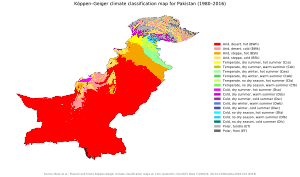
Pakistan's climate varies from a continental type of climate in the north (Gilgit-Baltistan,Kashmir,KPK), a mountainous dry climate in the west (Baluchistan), a wet climate in the East (Punjab) an arid climate in the Thar Desert, to a tropical climate in the southeast (Sindh), characterized by extreme variations in temperature, both seasonally and daily, because it is located on a great landmass barely north of the Tropic of Cancer (between latitudes 25° and 37° N).
Very high altitudes modify the climate in the cold, snow-covered northern mountains; temperatures on the Balochistan plateau are somewhat higher. Along the coastal strip, the climate is modified by sea breeze. In the rest of the country, temperatures reach great heights in the summer; the mean temperature during June is 38 °C (100 °F) in the plains, the highest temperatures can exceed 53 °C (127 °F). During summer, hot winds called Loo blow across the plains during the day. Trees shed their leaves to avoid loss of moisture. Pakistan recorded one of the highest temperatures in the world, 53.7 °C (128.66 °F) on 28 May 2017, the hottest temperature ever recorded in Pakistan and also the second hottest measured temperature ever recorded in Asia.[1]
The dry, hot weather is broken occasionally by dust storms and thunderstorms that temporarily lower the temperature. Evenings are cool; the daily variation in temperature may be as much as 11 °C to 17 °C. Winters are cold, with minimum mean temperatures in Punjab of about 4 °C (39 °F) in January, and sub-zero temperatures in the far north and Balochistan.
Winters are extremely cold in the north and the milder they get the more you go to the south.Spring causes heavy rainfall in the northern parts while it is mild in most parts of Pakistan.Summers are sweltering,boiling and extremely hot in central balochistan,southern Punjab and upper sindh while it gets milder the more you go to the north and the coast. The Monsoon season(late June-late September) also occurs in the summer season. Autumn is pleasant but gets cooler day by day with almost no rainfall. Winter in some parts even starts in late October-early November.
- ^ "WMO verifies 3rd and 4th hottest temperature recorded on Earth". World Meteorological Organization. 18 June 2019. Archived from the original on 18 December 2023. Retrieved 8 May 2020.
© MMXXIII Rich X Search. We shall prevail. All rights reserved. Rich X Search
